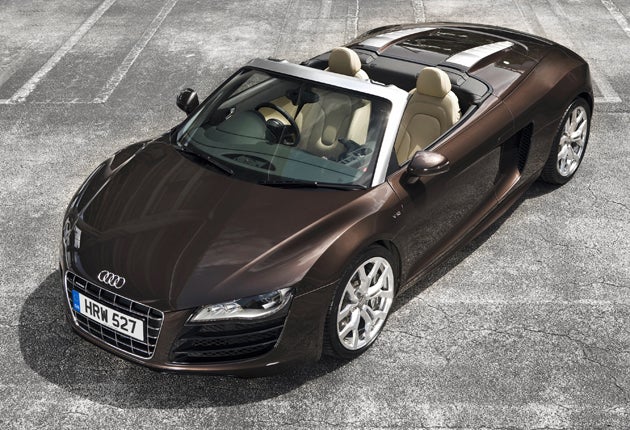Audi R8 V10 Spyder
The Audi R8 V10 Spyder is in a class of its own

Your support helps us to tell the story
From reproductive rights to climate change to Big Tech, The Independent is on the ground when the story is developing. Whether it's investigating the financials of Elon Musk's pro-Trump PAC or producing our latest documentary, 'The A Word', which shines a light on the American women fighting for reproductive rights, we know how important it is to parse out the facts from the messaging.
At such a critical moment in US history, we need reporters on the ground. Your donation allows us to keep sending journalists to speak to both sides of the story.
The Independent is trusted by Americans across the entire political spectrum. And unlike many other quality news outlets, we choose not to lock Americans out of our reporting and analysis with paywalls. We believe quality journalism should be available to everyone, paid for by those who can afford it.
Your support makes all the difference.What is it about open cars? Depending on your point of view, they either let you see, hear and feel the world outside with a clarity and exhilaration denied to those riding under a roof, or they let the outside world see you and, unless you're more attractive than me (which is likely), mock your exhibitionism.
Either way, we assume the purity of the car is somehow compromised unless a) the car type exists only in open form, or b) it existed as an open car before a closed one joined it.
Or so I thought, until I drove the Audi R8 V10 Spyder. An open Porsche 911 is all wrong, and Spyder versions of a Ferrari F430 or a Lamborghini Gallardo seem similarly to shoot their pedigree in the foot. But the Audi somehow gets away with it. How?
A closed R8 has striking, contrasting "blades" on its flanks aft of the doors and forming the rear cabin pillars, which clearly wouldn't work on a Spyder. Instead, the Spyder has extended side-scoops flowing into where the blade would be, which completely alters the R8 look. Thus the R8 Spyder looks like its own car and not a chopped-down version of another one. It helps, too, that the result has strong overtones of real sports-racing cars, such as – conveniently – the eponymous R8 (or later R10) that raced at Le Mans.
Of course the R8 Spyder is laden with goodies (B&O stereo, parking sensors, LED headlights, sat nav and a microphone in the driver's seatbelt), but they are discreet and don't spoil the impression of functional starkness. It's a pure sort of car, built for a purpose higher than showing off. That said, an audience will surely gather when the roof performs its kinetic art.
As the powered roof opens, its fabric folds into a Z-shape, the flying buttresses at the rear fold on to themselves, and the whole lot disappears under a painted carbonfibre cover, all in 19 seconds. There's a small rear window that can retract electrically into the rear deck, and a clip-on wind deflector to fit in front of it, if needed.
With the roof closed, the driving experience is as pure and as thrilling as it is in the coupé. There's hardly any audible difference, thanks to the roof's perfect fit and sealing ability against wind rush.
But with it open, the experience intensifies. This 5,204cc, 525bhp, direct-injection V10 has always sounded gutturally fabulous, like two 1980s Audi Quattro rally cars accelerating at full bore side by side, except that here you have 8,500rpm to play with. With no roof, you can now hear the harmonic battle as 10 cylinders with uneven firing intervals bellow their intent. It's marvellous.
It starts as a deep granular hum, goes through a vibratory growl around 3,000rpm, then morphs into that 10-cylinder harmonic howl. But this is not a peaky engine; maximum pulling power (390lb ft) doesn't arrive till 6,500rpm but the Spyder pulls lustily from under 2,000rpm, whatever gear.
Using "launch control" for an optimum getaway, the Spyder will reach 62mph in 4.1 seconds, as all four wheels share the traction. Both manual and paddleshift R-tronic versions have this electronic aid, which automatically manages throttle and traction control (and clutch engagement on the R-tronic). It works perfectly.
With the magnetically variable suspension dampers set to Sport, the R8 scythes through twists and turns, provided the road is ultra-smooth. The surprise is that Normal mode gives a more compliant ride than most other Audis, sporting or not. Yet it remains crisp and responsive, making this a supercar as civilised as it is engaging.
But it's not perfect. The R-tronic still surges annoyingly in automatic mode. (I'd still prefer a proper manual.) Nor is there much room for luggage.
Some say the R8 V10 Spyder is too dear: starting at £112,500, no Audi costs more. But it's a supercar that just happens to wear four rings. A credible open-top supercar? No, it's the best.
The Rivals
Aston Martin DBS Volante: £179,500.
The 5.9-litre, 510bhp V12 can't quite match R8 V10's pace, but some may prefer traditional front-engine design. Big, bulky and a beautiful finish.
Lamborghini Gallardo LP560-4 Spyder: £160,556.
Engine, transmission and aluminium structure are related to Audi's; power delivery is fiercer, price is higher, visuals are less pure.
Porsche 911 Turbo Cabriolet: £113,927.
Rapid and capable, defies physics with its 500bhp flat-six over-hanging the tail. Looks awkward: long overhangs, dumpy silhouette.
Join our commenting forum
Join thought-provoking conversations, follow other Independent readers and see their replies
Comments